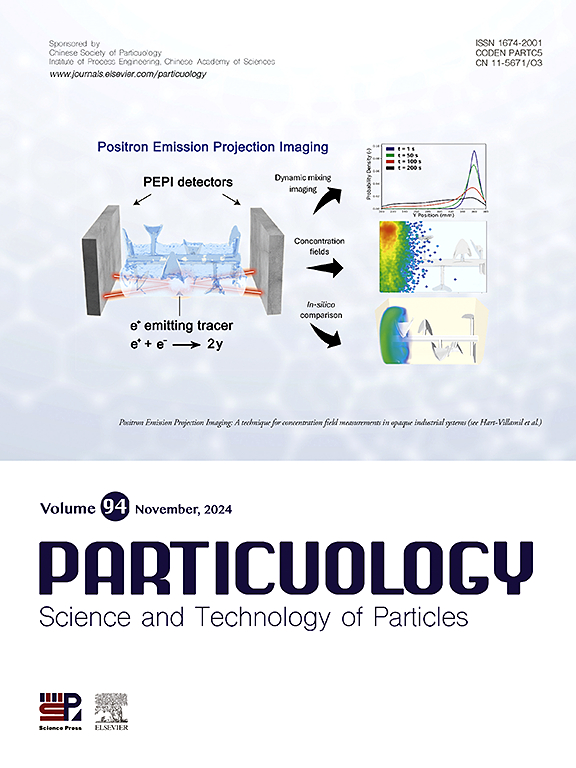Numerical simulations of a single particle for CO2 capture based on MgO sorbent
IF 4.1
2区 材料科学
Q2 ENGINEERING, CHEMICAL
引用次数: 0
Abstract
To obtain a deeper understanding of the mass transfer between MgO-based sorbent particles and gaseous reactants (CO2), it is essential to investigate the mass transfer characteristics of a single moving sorbent particle since most previous researches focused on the removal efficiency of the whole flow field and ignored the behavior of individual particles. Currently, most studies assumed that the reactant (CO2) concentration across the particle surface is uniform based on the average concentration within the grid, while the reactant concentration on the particle surface changes as the particle moves. In this study, the gas-solid mass transfer between CO2 and a moving MgO-based particle was investigated. The results indicated that the motion state and velocity of the particles significantly impact the CO2 removal dynamics and noticeable differences in the CO2 concentration gradient could be observed around the particle. Increasing the reaction temperature, enhancing the CO2 mass fraction at the inlet, appropriately increasing the gas velocity, and selecting an appropriate particle size can significantly enhance the reaction rate, thereby improving the CO2 removal efficiency. The correction formula for surface CO2 concentration and mass transfer reaction rate was also proposed based on the particle's velocity and direction of movement. Based on the correction formula, more detailed guidance for optimizing reactor design could be obtained and the findings provide theoretical guide for designing CO2 removal reactors.

基于氧化镁吸附剂的单颗粒CO2捕集的数值模拟
为了更深入地了解mgo基吸附剂颗粒与气态反应物(CO2)之间的传质特性,有必要研究单个运动吸附剂颗粒的传质特性,因为以往的研究大多侧重于整个流场的去除效率,而忽略了单个颗粒的行为。目前,大多数研究假设颗粒表面的反应物(CO2)浓度基于网格内的平均浓度是均匀的,而颗粒表面的反应物浓度随着颗粒的移动而变化。在这项研究中,研究了CO2与移动的mgo基颗粒之间的气固传质。结果表明,颗粒的运动状态和速度对CO2去除动力学有显著影响,颗粒周围CO2浓度梯度存在明显差异。提高反应温度,提高进口CO2质量分数,适当提高气速,选择合适的粒径,可显著提高反应速率,从而提高CO2的脱除效率。根据颗粒的运动速度和运动方向,提出了表面CO2浓度和传质反应速率的修正公式。基于修正公式,可以获得更详细的反应器优化设计指导,研究结果为CO2去除反应器的设计提供理论指导。
本文章由计算机程序翻译,如有差异,请以英文原文为准。
求助全文
约1分钟内获得全文
求助全文
来源期刊

Particuology
工程技术-材料科学:综合
CiteScore
6.70
自引率
2.90%
发文量
1730
审稿时长
32 days
期刊介绍:
The word ‘particuology’ was coined to parallel the discipline for the science and technology of particles.
Particuology is an interdisciplinary journal that publishes frontier research articles and critical reviews on the discovery, formulation and engineering of particulate materials, processes and systems. It especially welcomes contributions utilising advanced theoretical, modelling and measurement methods to enable the discovery and creation of new particulate materials, and the manufacturing of functional particulate-based products, such as sensors.
Papers are handled by Thematic Editors who oversee contributions from specific subject fields. These fields are classified into: Particle Synthesis and Modification; Particle Characterization and Measurement; Granular Systems and Bulk Solids Technology; Fluidization and Particle-Fluid Systems; Aerosols; and Applications of Particle Technology.
Key topics concerning the creation and processing of particulates include:
-Modelling and simulation of particle formation, collective behaviour of particles and systems for particle production over a broad spectrum of length scales
-Mining of experimental data for particle synthesis and surface properties to facilitate the creation of new materials and processes
-Particle design and preparation including controlled response and sensing functionalities in formation, delivery systems and biological systems, etc.
-Experimental and computational methods for visualization and analysis of particulate system.
These topics are broadly relevant to the production of materials, pharmaceuticals and food, and to the conversion of energy resources to fuels and protection of the environment.
 求助内容:
求助内容: 应助结果提醒方式:
应助结果提醒方式:


